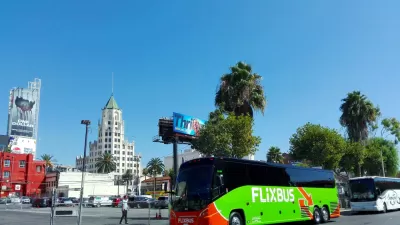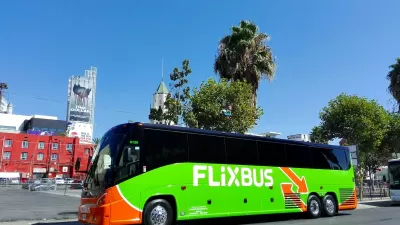Riders on the ‘forgotten stepchild’ of the U.S. transportation system find themselves waiting for buses curbside as Greyhound sells off its real estate in many U.S. cities.

“More people are taking long-distance bus trips than at any time since the start of the pandemic. Unfortunately, they have fewer places where they can get on and off.” Jared Brey outlines the issue in Governing, writing that intercity bus service has recovered by 85 to 90 percent since the pandemic, according to the Chaddick Institute for Metropolitan Development at DePaul University.
However, Greyhound closed multiple major stations around the country last year, forcing passengers to wait for buses on public sidewalks with no services or amenities. In Philadelphia, the closure of a downtown bus terminal “was seen locally as a disaster, with riders waiting for long stretches on the sidewalk with no shelter or restrooms — and sometimes having a hard time finding information about where and when the bus was coming. The buses also idled in a lane that was meant to be dedicated to local transit.” The closure of terminals not only makes travel more unsafe and inconvenient for riders, but also impedes other traffic and makes it more difficult to link inter-operator trips.
Brey notes that “Some states are having success with state-run intercity bus services, including Virginia Breeze and Bustang in Colorado, both of which saw big increases in ridership in 2023.” Additionally, “The Infrastructure Investment and Jobs Act also provides fundings that cities and states could use to invest in transportation terminals.”
Joseph Schwieterman, director of the Chaddick Institute, says he expects more collaboration between Amtrak and intercity bus lines in the near future.
FULL STORY: More Riders, Fewer Stations for Intercity Bus Lines

Maui's Vacation Rental Debate Turns Ugly
Verbal attacks, misinformation campaigns and fistfights plague a high-stakes debate to convert thousands of vacation rentals into long-term housing.

Planetizen Federal Action Tracker
A weekly monitor of how Trump’s orders and actions are impacting planners and planning in America.

In Urban Planning, AI Prompting Could be the New Design Thinking
Creativity has long been key to great urban design. What if we see AI as our new creative partner?

King County Supportive Housing Program Offers Hope for Unhoused Residents
The county is taking a ‘Housing First’ approach that prioritizes getting people into housing, then offering wraparound supportive services.

Researchers Use AI to Get Clearer Picture of US Housing
Analysts are using artificial intelligence to supercharge their research by allowing them to comb through data faster. Though these AI tools can be error prone, they save time and housing researchers are optimistic about the future.

Making Shared Micromobility More Inclusive
Cities and shared mobility system operators can do more to include people with disabilities in planning and operations, per a new report.
Urban Design for Planners 1: Software Tools
This six-course series explores essential urban design concepts using open source software and equips planners with the tools they need to participate fully in the urban design process.
Planning for Universal Design
Learn the tools for implementing Universal Design in planning regulations.
planning NEXT
Appalachian Highlands Housing Partners
Mpact (founded as Rail~Volution)
City of Camden Redevelopment Agency
City of Astoria
City of Portland
City of Laramie





























